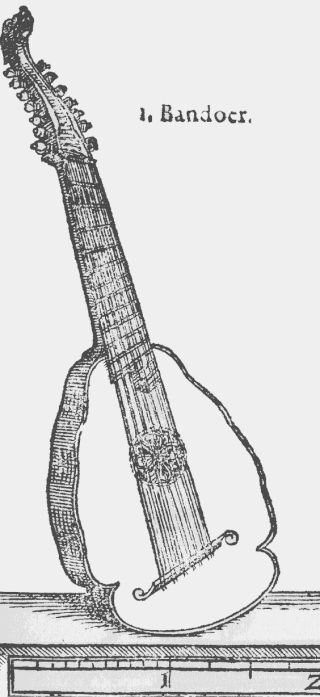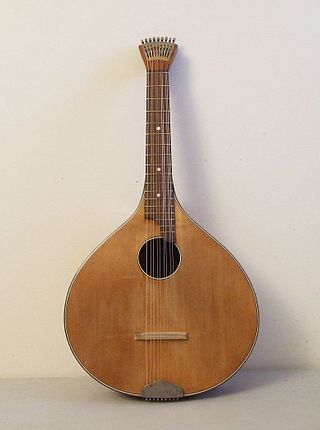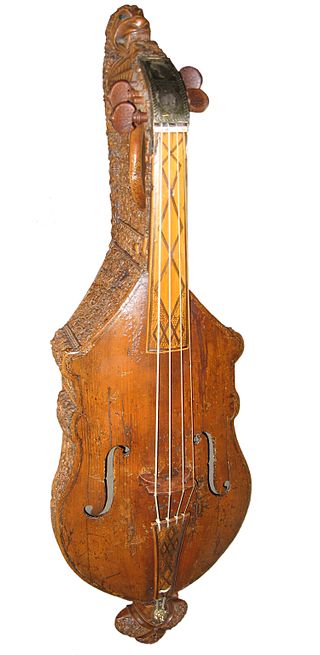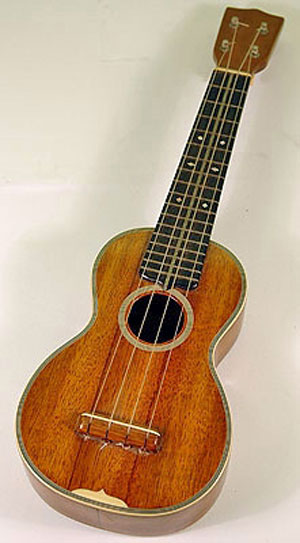Related Research Articles
A mandolin is a stringed musical instrument in the lute family and is generally plucked with a pick. It most commonly has four courses of doubled strings tuned in unison, thus giving a total of 8 strings, although,there are 4 string, 5 string, 6 string, 5 double string, 6, and even 4 a triple string course versions also exist. A variety of string types are used, with steel strings being the most common and usually the least expensive. The courses are typically tuned in an interval of perfect fifths, with the same tuning as a violin. Also, like the violin, it is the soprano member of a family that includes the mandola, octave mandolin, mandocello and mandobass.

The bouzouki, also spelled buzuki or buzuci, is a musical instrument popular in Greece. It is a member of the long-necked lute family, with a round body with a flat top and a long neck with a fretted fingerboard. It has steel strings and is played with a plectrum producing a sharp metallic sound, reminiscent of a mandolin but pitched lower. There are two main types of bouzouki: the trichordo (three-course) has three pairs of strings and the tetrachordo (four-course) has four pairs of strings. The instrument was brought to Greece in the early 1900s by Greek refugees from Anatolia, and quickly became the central instrument to the rebetiko genre and its music branches. It is now an important element of modern Laïko pop Greek music.

The cittern or cithren is a stringed instrument dating from the Renaissance. Modern scholars debate its exact history, but it is generally accepted that it is descended from the Medieval citole. Its flat-back design was simpler and cheaper to construct than the lute. It was also easier to play, smaller, less delicate and more portable. Played by people of all social classes, the cittern was a premier instrument of casual music-making much as is the guitar today.

The seven-string guitar adds one additional string to the more common six-string guitar, commonly used to extend the bass range or also to extend the treble range.

The bandora or bandore is a large long-necked plucked string-instrument that can be regarded as a bass cittern though it does not have the re-entrant tuning typical of the cittern. Probably first built by John Rose in England around 1560, it remained popular for over a century. A somewhat smaller version was the orpharion.

The Russian guitar (sometimes referred to as a "Gypsy guitar") is an acoustic seven-string guitar that was developed in Russia toward the end of the 18th century: it shares most of its organological features with the Spanish guitar, although some historians insist on English guitar descent. It is known in Russian as the semistrunnaya gitara (семиструнная гитара), or affectionately as the semistrunka (семиструнка), which translates to "seven-stringer". These guitars are most commonly tuned to an open G chord as follows: D2 G2 B2 D3 G3 B3 D4. In classical literature, the lowest string (D) occasionally is tuned down to the C.

The Irish bouzouki is an adaptation of the Greek bouzouki. The newer Greek tetrachordo bouzouki was introduced into Irish traditional music in the mid-1960s by Johnny Moynihan of the folk group Sweeney's Men. Alec Finn, first in the Cana Band and subsequently in De Dannan, introduced the first Greek trichordo (3 course) bouzouki into Irish music.

The waldzither is a plucked string instrument from Germany that came up around 1900 in Thuringia. It is a type of cittern that has nine steel strings in five courses. Different types of waldzither come in different tunings, which are generally open tunings as usual in citterns. The most common type has the tuning C3*G3 G3*C4 C4*E4 E4*G4 G4.

The citole was a string musical instrument, closely associated with the medieval fiddles and commonly used from 1200–1350. It was known by other names in various languages: cedra, cetera, cetola, cetula, cistola, citola, citula, citera, chytara, cistole, cithar, cuitole, cythera, cythol, cytiole, cytolys, gytolle, sitole, sytholle, sytole, and zitol. Like the modern guitar, it was manipulated at the neck to get different notes, and picked or strummed with a plectrum. Although it was largely out of use by the late 14th century, the Italians "re-introduced it in modified form" in the 16th century as the cetra, and it may have influenced the development of the guitar as well. It was also a pioneering instrument in England, introducing the populace to necked, plucked instruments, giving people the concepts needed to quickly switch to the newly arriving lutes and gitterns. Two possible descendant instrument are the Portuguese guitar and the Corsican Cetera, both types of cittern.

A course, on a stringed musical instrument, is either one string or two or more adjacent strings that are closely spaced relative to the other strings, and typically played as a single string. The strings in each multiple-string course are typically tuned in unison or an octave.
The Ceterone (Italian), was an enlarged cetera, believed to be similar to the chitarrone as a development of the chitarra and lute to enhance the bass capabilities of these instruments.

On a stringed instrument, a break in an otherwise ascending order of string pitches is known as a re-entry. A re-entrant tuning, therefore, is a tuning where the strings are not all ordered from the lowest pitch to the highest pitch.

There are many varieties of ten-string guitar, including:
This is a chart of stringed instrument tunings. Instruments are listed alphabetically by their most commonly known name.

The cythara is a wide group of stringed instruments of medieval and Renaissance Europe, including not only the lyre and harp but also necked, string instruments. In fact, unless a medieval document gives an indication that it meant a necked instrument, then it likely was referring to a lyre. It was also spelled cithara or kithara and was Latin for the Greek lyre. However, lacking names for some stringed instruments from the medieval period, these have been referred to as fiddles and citharas/cytharas, both by medieval people and by modern researchers. The instruments are important as being ancestors to or influential in the development of a wide variety of European instruments, including fiddles, vielles, violas, citoles and guitars. Although not proven to be completely separate from the line of lute-family instruments that dominated Europe, arguments have been made that they represent a European-based tradition of instrument building, which was for a time separate from the lute-family instruments.

Mandobass is the largest member of the mandolin family, sometimes used as the bass instrument in mandolin orchestras. It is so large that it usually is not held in the lap, but supported on a spike that rests on the floor. The neck-scale length on a full-size mando-bass is similar to that of a standard orchestral double bass viol: about 43 inches (110 cm). The instrument is otherwise similar to the smaller, higher-pitched members of the mandolin family, having a fretted neck, a headstock with geared tuning machines, and a large resonating body often—but not always—shaped like that of other mandolins.

Laúd is a plectrum-plucked chordophone from Spain, played also in diaspora countries such as Cuba and the Philippines.

The English guitar or guittar is a stringed instrument – a type of cittern – popular in many places in Europe from around 1750–1850. It is unknown when the identifier "English" became connected to the instrument: at the time of its introduction to Great Britain, and during its period of popularity, it was apparently simply known as guitar or guittar. The instrument was also known in Norway as a guitarre and France as cistre or guitarre allemande. There are many examples in Norwegian museums, like the Norsk Folkemuseum and in British ones, including the Victoria and Albert Museum. The English guitar has a pear-shaped body, a flat base, and a short neck. The instrument is also related to the Portuguese guitar and the German waldzither.

Repetitive tunings are alternative tunings for the guitar. A repetitive tuning begins with a list of notes that is duplicated, either at unison or at higher octaves.